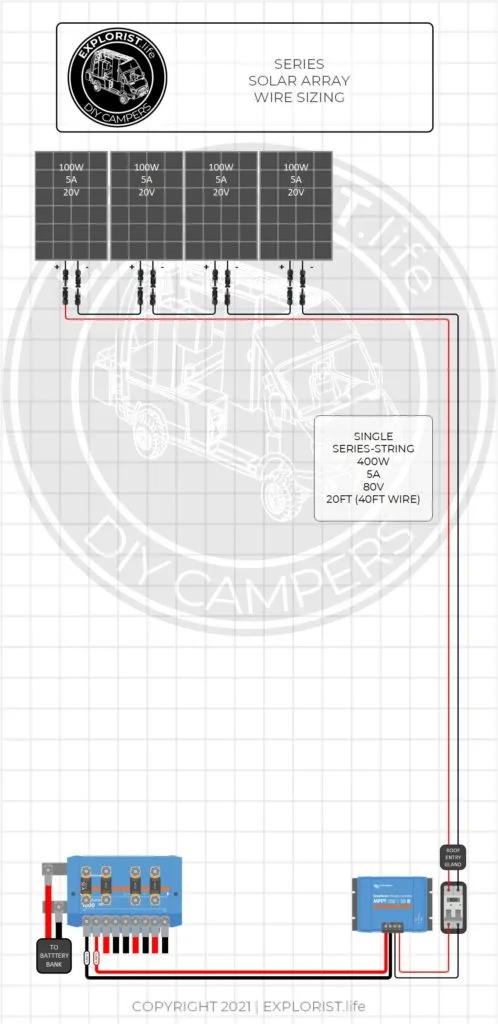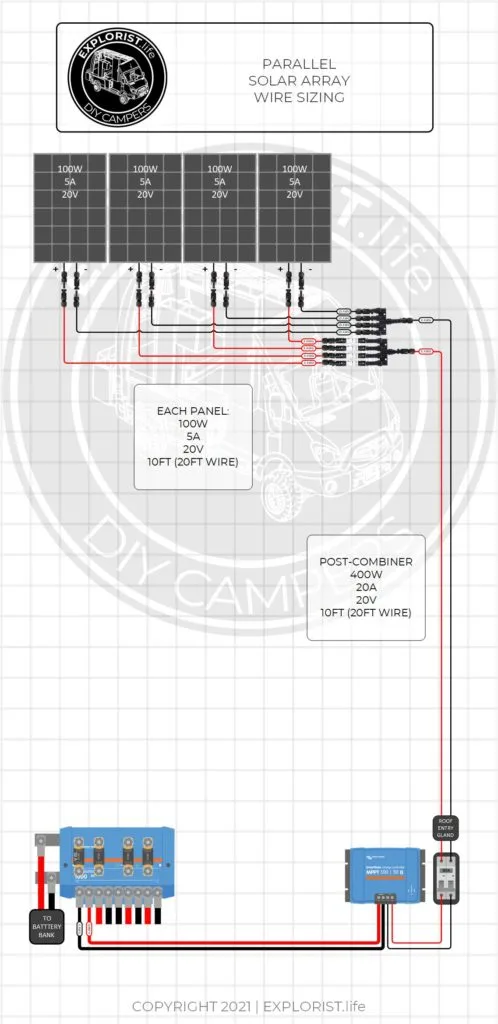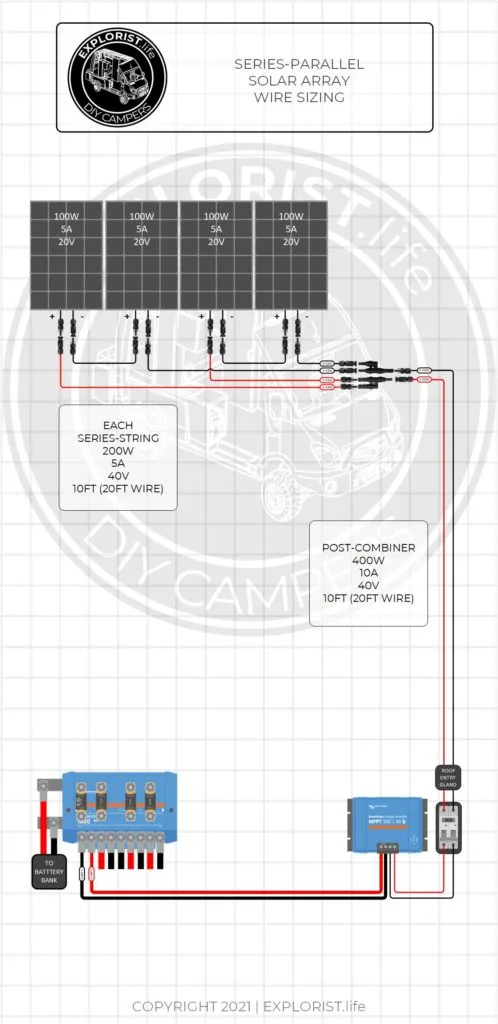This blog post will teach you what size of wire you need to wire your solar panels to your charge controller in your DIY camper electrical system. We will cover the ‘technical’ way to size wire and the ‘easy’ way to size wire.
The technical way to size solar array wire involves using the EXPLORIST.life wire sizing calculator to determine the proper size of wire based on the amps, voltage, allowable voltage drop, and length of the circuit.
The easy way involves verifying that 10 AWG wire is big enough and simply using 10 AWG Wire for the solar array wiring.
How to Choose Solar Panel Wire Size – Video
This video will teach you what size of wire you need to wire your solar panels to your charge controller in your DIY camper electrical system and will cover all of the concepts from this blog post
Wire Size Calculator
The EXPLORIST.life wire size calculator can always be found at https://www.explorist.life/wire-sizing-calculator/ and can be easily accessed by using the main website menu under the ‘Calculators’ heading.
Series Wired Solar Array Wire Size
A series wired solar array gets the voltage of each panel added together while the array amperage remains the same as a single panel.
This means that in the example below, there is 5 amps at 80 volts flowing through the wire from the solar panel to the charge controller.

It is 20ft from the solar array to the charge controller, which means that the 5 amps at 80 volts is flowing through 40ft of wire. Allowing for 3% voltage drop in the wire sizing calculator, we can see that we can use 16 AWG Wire for these wires.
Try it for yourself. The inputs are:
- 5 Amps
- 80 Volts
- 40 Feet
- Wire NOT installed in an engine compartment
- Only 2 wires in the bundle
- 3% allowable voltage drop
Parallel Wired Solar Array Wire Size
To determine the wire size necessary for a parallel wired solar array, we need two separate wire size calculations. Since the voltage and amperage flowing through the wires before the combiner is different than the voltage and amperage flowing through the wires after the combiner, we need to find the recommended wire size of each.
This means that in the example below, there are 5 amps at 20 volts flowing through the 20ft of wires from each of the solar panels, 10ft away to the MC4 Combiner. Allowing for a 1.5% voltage drop in the wire sizing calculator, we can see that we can use 14 AWG Wire for these wires.
After the Combiner, since parallel wired panels get their amperages added while their voltages stay the same, the wires would be delivering 20 amps at 20 volts through 20 feet of wire, 10 feet away to the charge controller. Allowing for a 1.5% voltage drop in the wire sizing calculator, we can see that we can use 8 AWG Wire for these wires.

Try it for yourself. Here are the inputs used:
- For Each Panel to the MC4 Combiner
- 5 Amps
- 20 Volts
- 20 Feet of Wire
- 1.5% allowable voltage drop
- From the MC4 combiner to the Charge Controller
- 20 Amps
- 20 Volts
- 20 Feet of Wire
- 1.5% allowable voltage drop
Series-Parallel Wired Solar Array Wire Size
To determine the wire size necessary for a series-parallel wired solar array, we need two separate wire size calculations similar to a parallel wired array. Since the voltage and amperage flowing through the wires before the combiner is different than the voltage and amperage flowing through the wires after the combiner, we need to find the recommended wire size of each.
This means that in the example below, there are 5 amps at 40 volts flowing through the 20ft of wires from each of the solar panel series-strings, 10ft away to the MC4 Combiner. Allowing for a 1.5% voltage drop in the wire sizing calculator, we can see that we can use 16 AWG Wire for these wires.
After the Combiner, since parallel wired series-strings of solar panels get their amperages added while their voltages stay the same, the wires would be delivering 10 amps at 40 volts through 20 feet of wire, 10 feet away to the charge controller. Allowing for a 1.5% voltage drop in the wire sizing calculator, we can see that we can use 14 AWG Wire for these wires.

Try it for yourself. Here are the inputs used:
- For each series-string to the MC4 Combiner
- 5 Amps
- 40 Volts
- 20 Feet of Wire
- 1.5% allowable voltage drop
- From the MC4 combiner to the Charge Controller
- 10 Amps
- 20 Volts
- 20 Feet of Wire
- 1.5% allowable voltage drop
Best Solar Array Wire Size – 10 AWG
A properly designed camper solar array SHOULD always be able to use 10 gauge wire for all wires between the array and the charge controller, and here is why…
Even if the calculator recommends a smaller wire, like 16 gauge… 10 gauge wire is simply more durable from a physical standpoint (think; big rope vs small rope). And since it will be installed on the roof of your camper, out in the elements, having a more durable wire is a very good thing.
This ‘larger-then-necessary’ wire size will also cut down on voltage drop, which will help deliver every drop of power from your array to your charge controller.
Now… What if the calculator recommends a wire size larger than 10 AWG?
If that were the case… I’d take a step back and look at how the array is wired. For an MPPT charge controller to REALLY do it’s job, the array voltage really should be at least 20V over the battery bank voltage. This higher voltage will also keep the array amperage lower, which will let us use a smaller wire size.
How many watts of solar can run on 10 AWG wire?
High-quality 10 gauge wire with 105-degree celsius insulation is rated with a max ampacity of 60A. Most MC4 connectors, on the other hand, have a max ampacity of 30A; so we need to keep the array amperage below 30A; and we can do that by wiring the array in series or series-parallel so the array has a lower amperage and a higher voltage.
This means that with an array amperage of 30A, feeding say… 250V into a big SmartSolar MPPT 250|100… Using watts law of 30A x 250V… this would actually give us an array wattage of 7500W of solar panels; which is a LOT. In fact… that’s about 150% the max rated wattage capacity of that SmartSolar MPPT charge controller when paired with a 48V battery bank. So the wattage of the array…doesn’t REALLY matter when trying to see if we can use 10 gauge wire.
So, if you are trying to design a solar array on your own… use the ‘technical’ methods I taught you earlier to double check that 10AWG is indeed large enough and again… if 10 AWG isn’t large enough… consider re-working your array design to have more panels in larger series strings to boost the array voltage and lower the array amperage so you CAN use 10 AWG wire.
Why not just use larger than 10 AWG Wire?
Generally, the only reason a solar array would need to use larger than 10 AWG wire would be to reduce the voltage drop from the array to the charge controller. Since we are talking about camper solar arrays where the length of the entire camper is likely under 45ft, though… The chances of the wires from the array to the charge controller being over, say, 50-60ft would be rare. On a properly designed solar array, achieving a 3% or less voltage drop with 10AWG wire is easily achievable.
Post time: Oct-12-2022